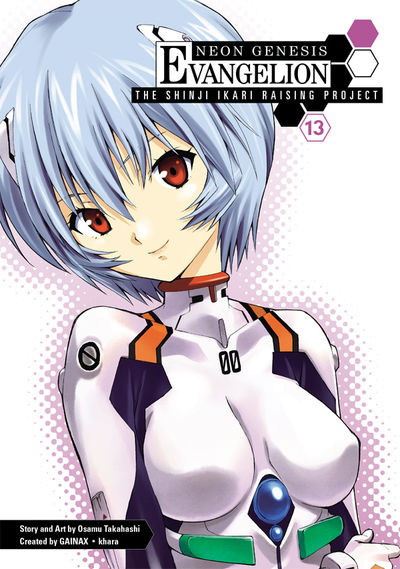MANGA MONDAYS: NEON GENESIS EVANGELION—
THE SHINJI IKARI RAISING PROJECT VOL. 13

Moeeeeee—that's a common reaction to Rei Ayanami as depicted on the cover of Neon Genesis Evangelion: The Shinji Ikari Raising Project vol. 13, out in stores this week. And, as editor of both titles, I couldn't help but contrast it with that moment in Evangelion: Comic Tribute where one of the members of SEELE admits he finds exciting the idea of Rei "looking at me disdainfully with those cold, soulless eyes."
Now vol. 13 of The Shinji Ikari Raising Project came out in Japan in 2012, the same year as the most recent Evangelion movie, Evangelion: 3.0 You Can (Not) Redo. If you've seen 3.0 (if you haven't, it's coming to a theater near you), you know that in it Rei would definitely get that SEELE of approval. So how can they both be the same—that Rei in the movie, and this Rei with the smile and welcoming, pigment-free visage?
Ultimately, it's the Japanese fans that decided to accept both of them as versions of Rei; that's what makes the parallel success of The Shinji Ikari Raising Project so interesting to observe. The grim, intense You Can (Not) Redo was the biggest box-office success yet for Evangelion. Yet vol. 15 of The Shinji Ikari Raising Project came out in Japan earlier this year, and as the original Evangelion manga by series co-creator Yoshiyuki Sadamoto will conclude next year with vol. 14, that means there are now more volumes of this spinoff version of Eva than the original one.
Another way to look at it is this: The Shinji Ikari Raising Project vol. 1 came out in Japan in March of 2006, a year and a half before the first of the current Rebuild Evangelion films, 1.0 You Are (Not) Alone, premiered in Japan. In other words, the manga established its readership among Eva fans well before the current revival started, and has kept it all through the new movies, despite having a very different tone than those films. When you look at both these interpretations of Neon Genesis Evangelion—action and melancholy versus humor and affection—you better understand Eva as the phenomenon it surely is, and not just as a single story.
Do we have the courage to receive your own opinions on Neon Genesis Evangelion? Yes we do, in our Evangelion letters and fan art section that runs in the back of every Eva manga, entitled "Misato's Fan Service Center" (so maybe it's liquid courage). Send us your thoughts on all aspects of Evangelion at the aptly-inscribed address evangelion@darkhorse.com. Just like Rei, we contain multitudes!
—Carl Horn, Manga Editor
P.S. You probably know this, but moe is pronounced "moh-eh," not as in Moe, Larry and Curly. Although, in the scene in Sadamoto's original Eva manga where the twin angels Israfel toss Unit-01 and Unit-02 together to collide in mid-air, I dearly wanted a coconut-like sound effect at just that moment. What's "nyuk-nyuk" in Enochian?